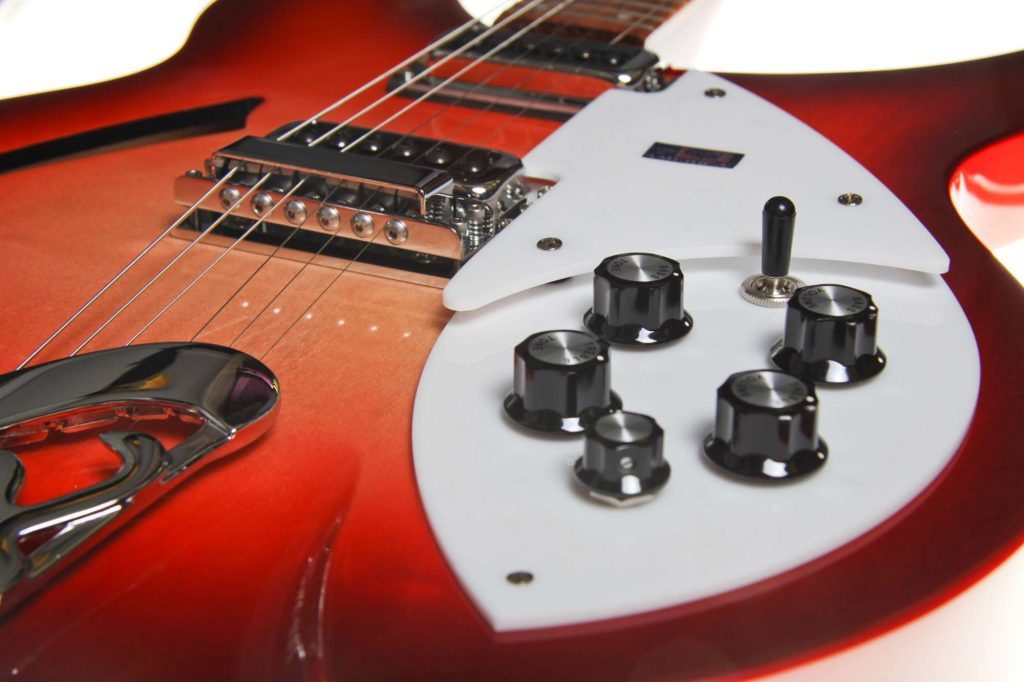June 17, 2015 / Tagged: Beginner Lessons, Music History /
Author: Lucas Frost

3. Hollow & Electric: The Rickenbacker 330
The resilience of the Rickenbacker 330 hollow-body electric guitar
During the 1950s, the popularity of the Fender Telecaster and the Gibson Les
Rickenbacker was the 1st Company to Specialize in Electric Instruments
Rickenbacker is central to the story of the guitar. It was the first company to specialize in electric instruments, and pioneered the mysteries of electro-magnetic music throughout the 1920s and 1930s. Noteworthy is the Hawaiian steel guitar known as the Frying Pan (due to its shape). The entire guitar was made out of a single block of aluminium and as a result suffered from tuning problems, as the whole instrument expanded under the heat of the stage lights. Rickenbacker also made a standard electric guitar, the Bakelie Model B which was introduced in 1935 – made out of the same material as bowling balls, it was heavy and reduced the feedback problems associated with hollow-body electrics. In 1958, Rickenbacker launched its most successful model, the 330. It’s a semi-acoustic.
The Main Difference is in the Tone
3 Advantages of Semi-Acoustics
- Lighter in weight (less back-pain)
- A more traditional, classic aesthetic
- Tone (main advantage)
Good Vibrations
Semi-acoustics come alive in all their responsive richness, warm, ringing overtones and delicious sustain
This greater “vibrational sensitivity” has another effect: feedback. Semi-acoustics are infamous for their tendency to feedback easily, and solid-bodies were pretty much invented to reduce this effect – guitarists would stuff foam into the body or tape over the f-holes to control their guitar’s screech. But in the hands of great guitarists, their feedback can be used to marvellous effects. With the right distance to the amp and perhaps a hint of overdrive, semi-acoustics will come alive in all their responsive richness, warm, ringing overtones and delicious sustain. The creative use of the semi-acoustics feedback “problem” led to great experimentation of textured soundscapes.
The Rickenbacker gave its shimmering sound to some of the most innovative and experimental bands ever
The Rickenbacker 330 is a great example, an instrument that has give its shimmering sound to some of
This is how The Beatles, Oasis or The Smiths got that full, rich tapestry of sound
Standout Features of the Rickenbacker 330
And of course, the 330 has plenty of other features that make it stand out. Rickenbacker seems to have
doubled many standard features. Most Rickenbackers have two truss-rods,
side by side, which allow you to regulate the straightness of your neck
more accurately (but it also increases neck weight). Some of the
earlier 330s featured two output jacks, one for each pickup. This gave
you the option of playing through multiple amps to create new sound
palates, and gives you versatility with effect loops and a stereo stage
sound. And the 330 has two tone and volume knobs (one per pickup) with
the addition of a “blend” knob, which allows for a smooth tweaking of
your tone – a bit like a single band EQ. The thick, flat-wound
single-coil pickups accentuate clear, mid- to upper range tones with
good definition. And if you want even more harmonic richness, there was
the option of the 12-string 360 model [as seen in image].
